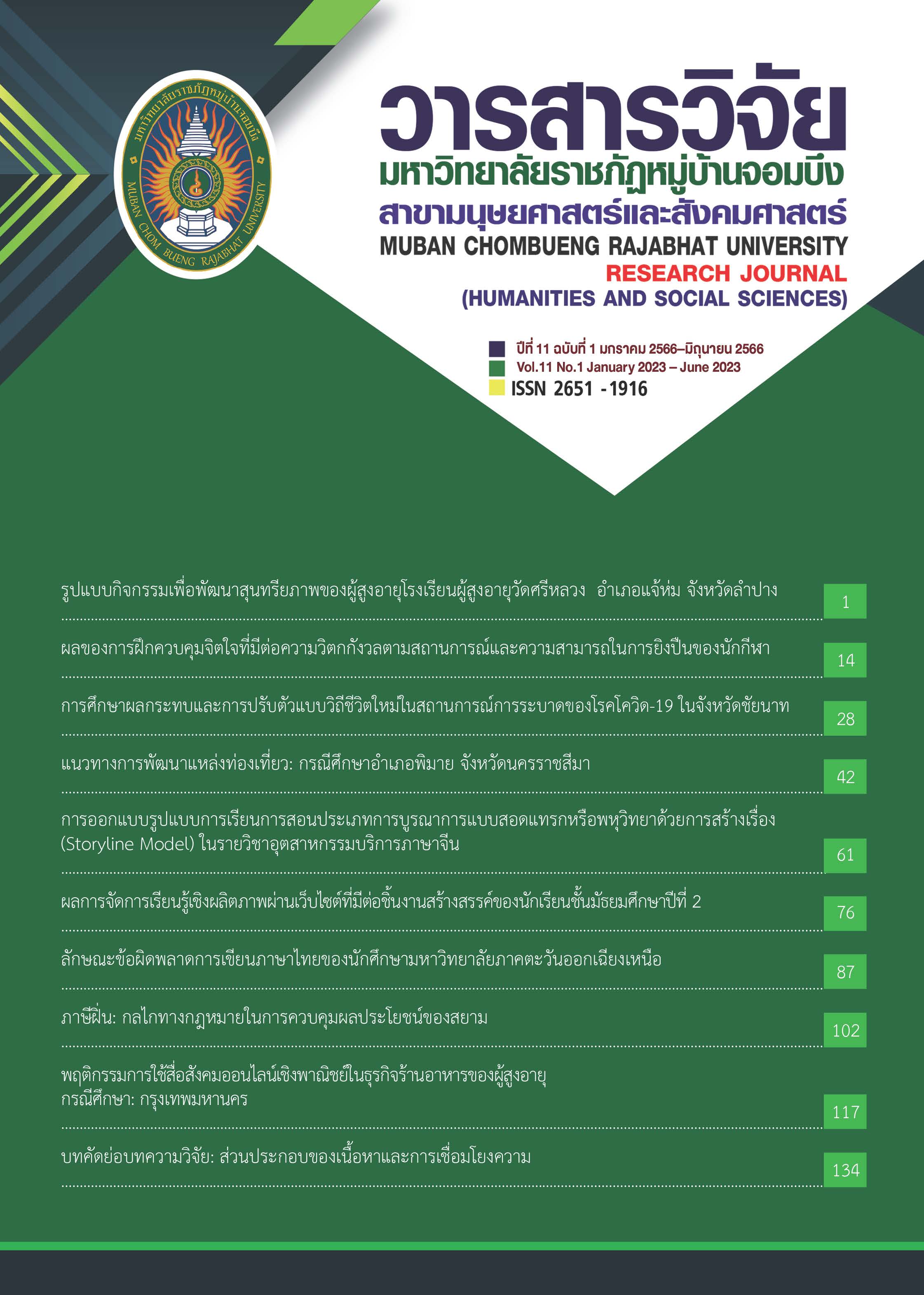Effects of using Productivity-Based Learning through Web-Based Instruction on Creative Products of Grade 8 Students.
Keywords:
Productivity-Based Learning, Web-Based Instruction, creative productsAbstract
The purpose of this research was to compare the evaluation results of creative products after using productivity-based learning through web-based instruction with the 70% criteria for full scores. The multi-stage random sampling consisted of 30 grade eight students in the first semester of the academic year 2021, studying at Bueng Kham Phroi Subdistrict Administrative Organization School 1 (Wat Rat Sattha Ram School), under the Department of Local Administration. The research instruments were: 1) ten plans of productivity-based learning through web-based instruction (online teaching) lasting 20 hours and appropriate at the highest level, 2) a creative product test with a reliability of 0.89, and 3) web-based instruction appropriate at the highest level with an efficiency value of 82.17/85.22. The statistics used for the data analysis were mean, percentage, standard deviation, and one sample t-test.
The findings revealed that the evaluation scores for the creative products after using productivity-based learning through web-based instruction were higher than the 70% criteria for full scores, at a statistical significance level of 0.05. ( = 16.97 out of a full score of 20, S.D. = 1.79).
References
กฤตยาณี กองอิ้ม. (2560). การพัฒนาระบบการเรียนการสอนบนเว็บตามแนวทางสะเต็มศึกษาเพื่อส่งเสริมความสามารถในการแก้ปัญหาอย่างสร้างสรรค์ สำหรับนักเรียนประถมศึกษาโรงเรียนสาธิตมหาวิทยาลัย สังกัดสำนักงานคณะกรรมการการอุดมศึกษา. วิทยานิพนธ์ดุษฎีบัณฑิต มหาวิทยาลัยมหาสารคาม.
กรมส่งเสริมการปกครองส่วนท้องถิ่น. (2564). ระบบสารสนเทศทางการศึกษาท้องถิ่น, สืบค้นเมื่อ 1 กันยายน 2564, จาก https://lec.dla.go.th.
ทิศนา แขมมณี. (2561). ศาสตร์การสอนองค์ความรู้เพื่อการจัดกระบวนการเรียนรู้ที่มีประสิทธิภาพ. กรุงเทพฯ: สำนักพิมพ์แห่งจุฬาลงกรณ์มหาวิทยาลัย.
นัสรินทร์ บือซา. (2558). ผลการจัดการเรียนรู้ตามแนวคิดสะเต็มศึกษา (STEM Education) ที่มีต่อผลสัมฤทธิ์ทางการเรียนชีววิทยา ความสามารถในการแก้ปัญหาและความพึงพอใจต่อการจัดการเรียนรู้ของนักเรียนชั้นมัธยมศึกษาปีที่ 5. วิทยานิพนธ์ศึกษาศาสตร์มหาบัณฑิต มหาวิทยาลัยสงขลานครินทร์.
ไพฑูรย์ สินลารัตน์ และคณะ. (2560). คิดผลิตภาพ : สอนและสร้างได้อย่างไร. กรุงเทพฯ: โรงพิมพ์แห่งจุฬาลงกรณ์มหาวิทยาลัย.
เลอลักษณ์ โอทกานนท์. (2561). มหาวิทยาลัย 4.0: การศึกษาเชิงผลิตภาพ. วารสารบัณฑิตศึกษา มหาวิทยาลัยราชภัฏวไลยอลงกรณ์ ในพระบรมราชูปถัมภ์. 12(3), 249-265.
วิจารณ์ พานิช. (2556). ทศวรรษเพื่อการพัฒนาระบบงานวิชาการรับใช้สังคม. วารสารการพัฒนาชุมชนและคุณภาพชีวิต. 1(1), 1-7.
สุวรรณา จุ้ยทอง. (2563). ผลการจัดกิจกรรมการเรียนรู้เชิงผลิตภาพ ที่มีต่อความสามารถในการสร้างผลงานของนักเรียนในระดับการศึกษาขั้นพื้นฐาน. วารสารวิชาการวิทยาลัยแสงธรรม. 12(1), 211-227.
Downloads
Published
How to Cite
Issue
Section
License
Copyright (c) 2023 Muban Chombueng Rajabhat University Research Journal (Humanities and Social Science)

This work is licensed under a Creative Commons Attribution-NonCommercial-NoDerivatives 4.0 International License.
Journal of TCI is Licensed under a Creative Commons Attribution-NonCommercial-NoDerivatives 4.0 International (CC BY-NC-ND 4.0) licence, unless otherwise stated, Please read our Policies page for more information on Open Access, copyright and permissions.



